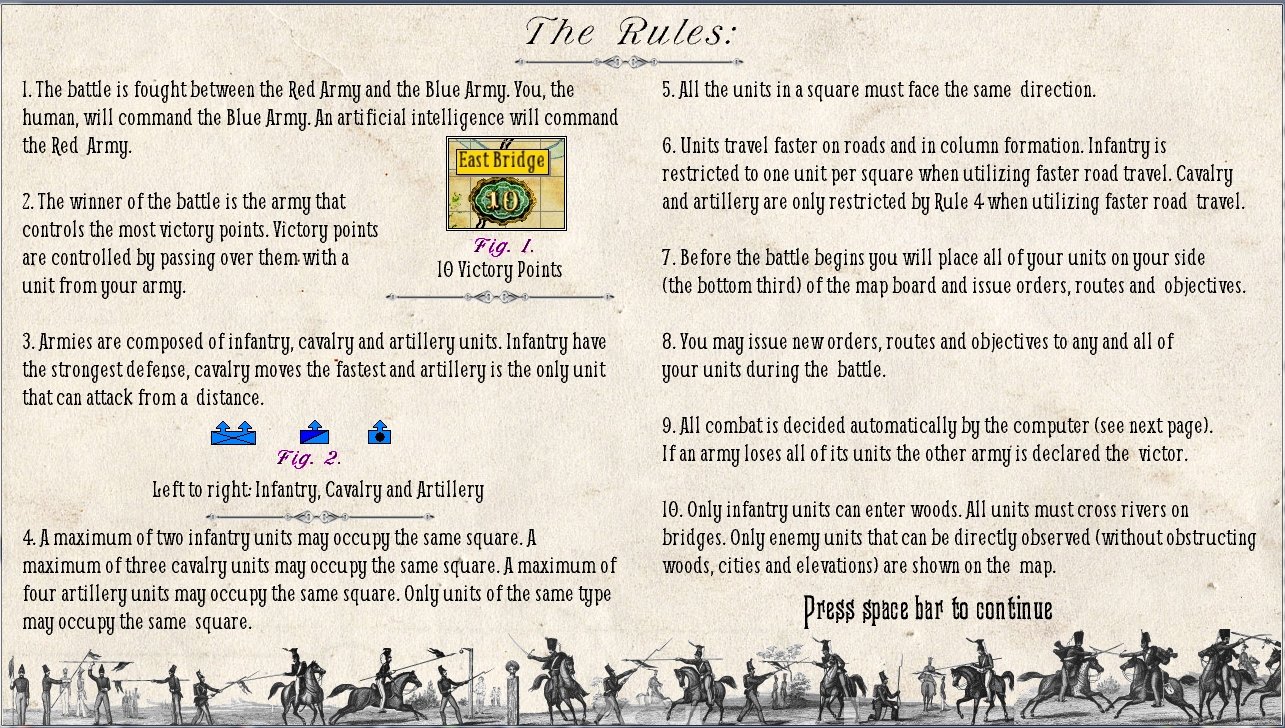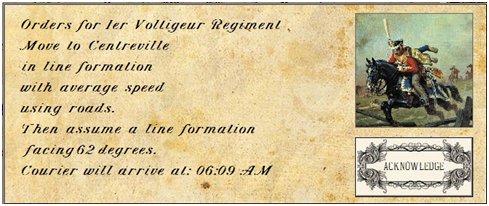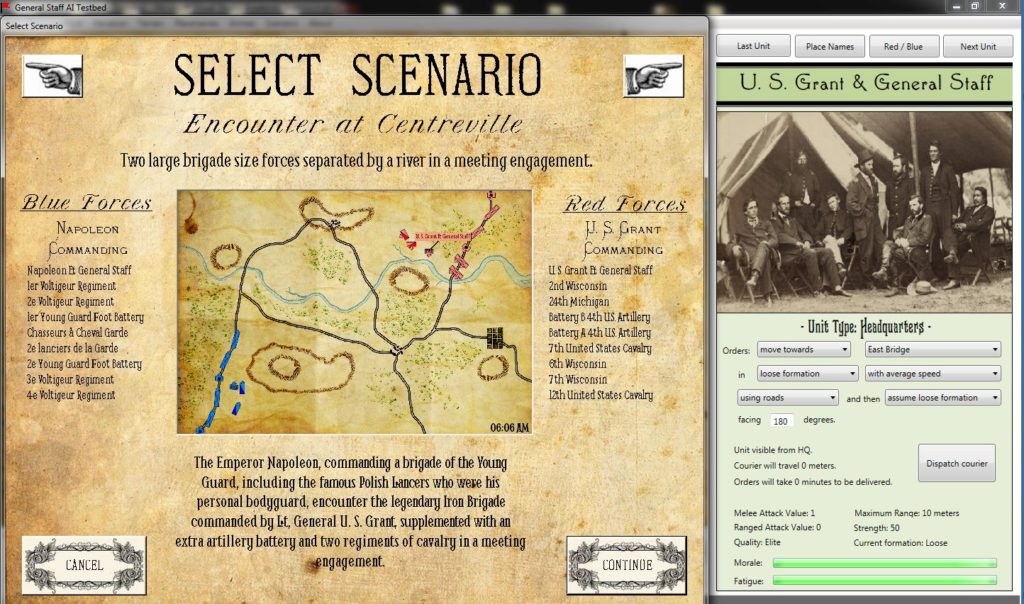We’re finishing up the Proof of Concept Demo and we wanted to post some screen shots.
Category Archives: Gameplay
The Fog of War
A key element of General Staff gameplay is the notion of ‘fog of war’. In essence we keep three maps: what blue thinks the situation is, what red thinks the situation is and where all units actually are on the map.
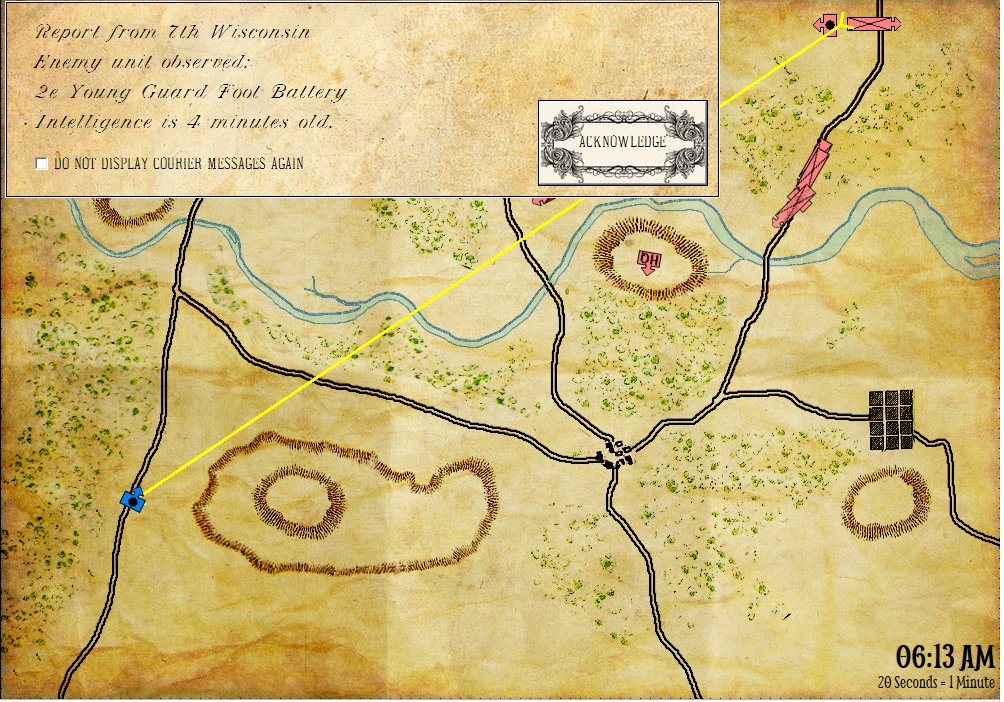
A courier reports that an enemy unit was observed four minutes ago. Note: the enemy unit has almost certainly moved on since then. (Click to enlarge.)
Location of your headquarters (HQ) unit is vitally important in General Staff. If an enemy (or friendly) unit is not directly observable to your HQ unit, the information of an enemy unit sighting is passed to HQ via courier. The amount of time for the courier to travel from the observing unit to the HQ is precisely calculated (see screen capture, above). Friendly units report their position every hour and dispatch a courier to HQ with this information as well. The time for a courier to travel from the reporting unit to travel to HQ is also calculated.
In essence, then, locating your HQ unit on a hill, ridge or other prominent feature is important if you want a clear view of the battlefield. Otherwise, you will be dependent on your couriers to penetrate the fog of war.
The phrase, ‘Fog of War’ (or Nebel des Krieges in German) was first written by Carl von Clauswitz in his famous treatise, On War (in 1832, first English translation in 1873):
War is the realm of uncertainty; three quarters of the factors on which action in war is based are wrapped in a fog of greater or lesser uncertainty. A sensitive and discriminating judgment is called for; a skilled intelligence to scent out the truth.
— Carl von Clausewitz
Update: some readers at Kriegsspiel Forum have quite correctly pointed out that at great distances units would certainly not be able to ascertain the name of the unit that they are observing. Consequently, we have changed the information provided to this:
Now the question arises: how far could you see with a 19th century telescope? Do we need to include a maximum range for line of sight? Interesting question. Would like to hear your comments.
General Staff Gameplay
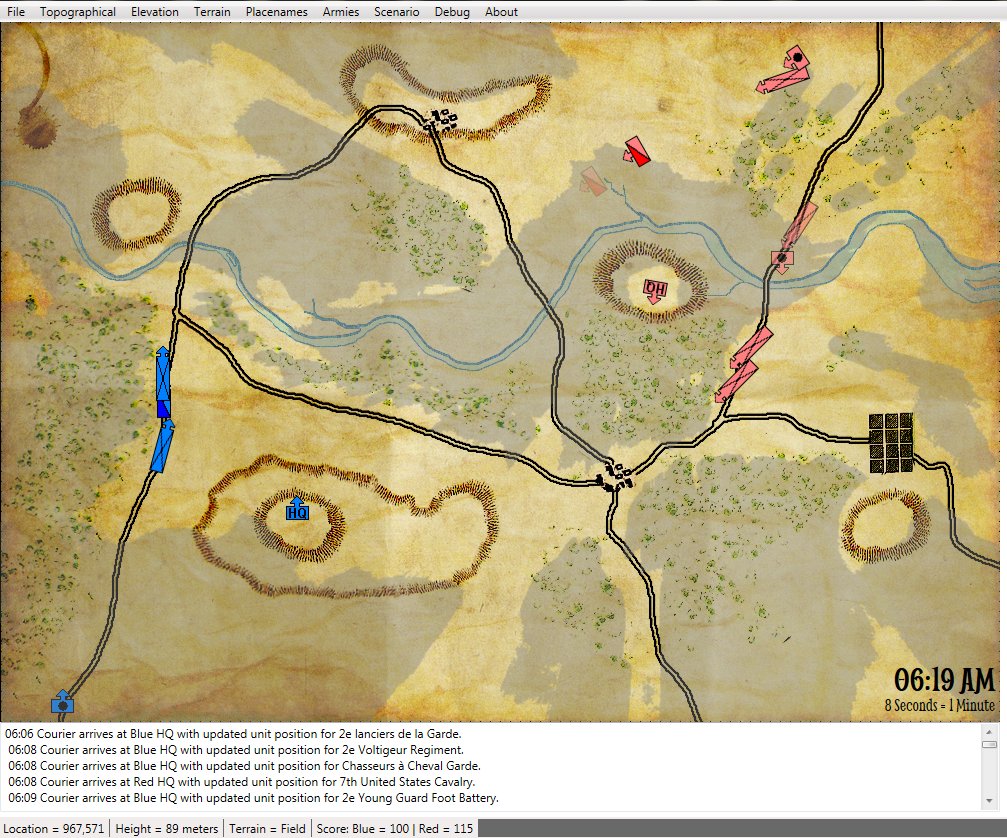
Screen capture of General Staff showing the 3D Line of Sight (LOS) areas that are visible to the Red HQ unit (grayish areas are not visible). (Click to enlarge.)
We are very pleased to show screen captures of General Staff that demonstrate some of its unique gamplay features. General Staff is different (at least as far as we know, and if there are other computer wargames that have these gameplay techniques, we haven’t seen them) in that you, the user, are assuming the role of the commanding general with his general staff. You do not have an omniscient view of the battlefield. The only unit locations (both friendly and OPFOR, or OPposition FORces) that you know for certain are the ones that you can directly observe. The above screen capture displays the areas that the Red HQ unit (U. S. Grant and staff) can see from their location on Riverview Hill. The 3D Line of Sight (3D LOS) algorithm in General Staff uses elevation and terrain maps to calculate the LOS for each unit.
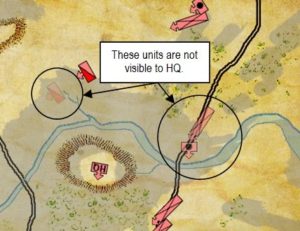
An example of how units that are not directly visible to HQ are displayed. The longer that a unit remains unobserved, the fainter it becomes. (Click to enlarge.)
When units are hidden from direct LOS they begin to fade (as seen in the screen capture to the right). The longer it has been since the unit has been observed, the fainter the unit is drawn. However, every hour, every friendly unit dispatches a courier to headquarters with its current unit location. When the courier arrives (his path is calculated and described below) the unit’s position is updated and the unit is displayed in full color. In the above screen capture, arriving messenger reports are displayed in the bottom of the screen. Enemy units, however, that have not been observed for an hour disappear completely from the map.
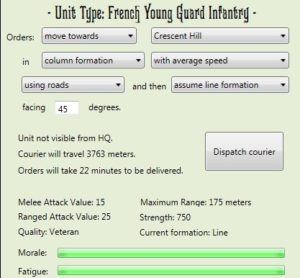
Screen capture showing easy to use interface for giving orders. Also displays unit information, distance from HQ, morale and fatigue. (Click to enlarge.)
Orders are not given directly to units, as in other wargames, but are sent, via courier, from HQ to the unit. The screen capture (right) shows the interface for constructing a unit’s orders. Orders are entered via unit-specific pop-up menus that specify the formation, direction, facing and speed for the unit. Also displayed is how far the messenger will travel and how long it will take for to deliver the orders. Couriers travel at 17.5 kilometers per hour and will attempt to use roads whenever possible.
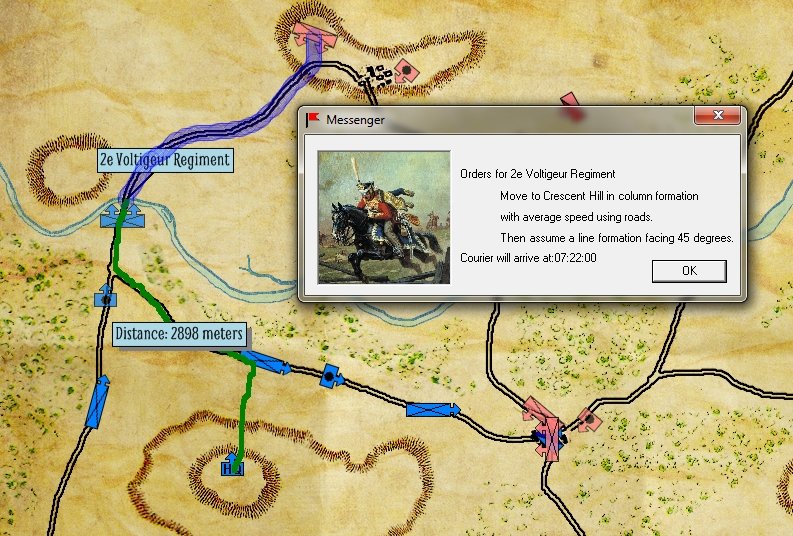
This screen capture displays the path from Blue HQ to the unit that the courier will travel (in green), the future orders for the unit (thicker blue) and confirmation of the orders. Note how the courier automatically takes advantage of roads. (Click to enlarge.)
The above screen capture shows the path the messenger will take (in green), the orders (in transparent blue) and a confirmation pop-up that shows the time the messenger will arrive at the unit with the new orders.
We have since updated the Messenger box to look like this (in keeping with the 19th century late Victorian theme of General Staff):
We believe that this structure not only is an authentic depiction of warfare in the 19th century and how the generals experienced ‘fog of war’, but will greatly enhance the gameplay of General Staff.
First Scenario Created!
The above is a screen capture of the Select Scenario screen from General Staff. We anticipate shipping with about 20-30 scenarios and this is the first. This first scenario is an – obviously – fantasy match-up between Napoleon commanding portions of the Young Guard and U. S. Grant commanding the famous Iron brigade supplemented with an extra artillery battery and two regiments of cavalry.
We anticipate producing three or more scenarios for every map that we create. Most of the maps will be of historical battles from the 19th century and before. Are there particular battles that you would like to see in General Staff? Please drop us a line.
This first scenario was created to test the AI (crossing rivers and defending bridges), taking advantage of hills and the road net.
New, Faster Pathfinding AI
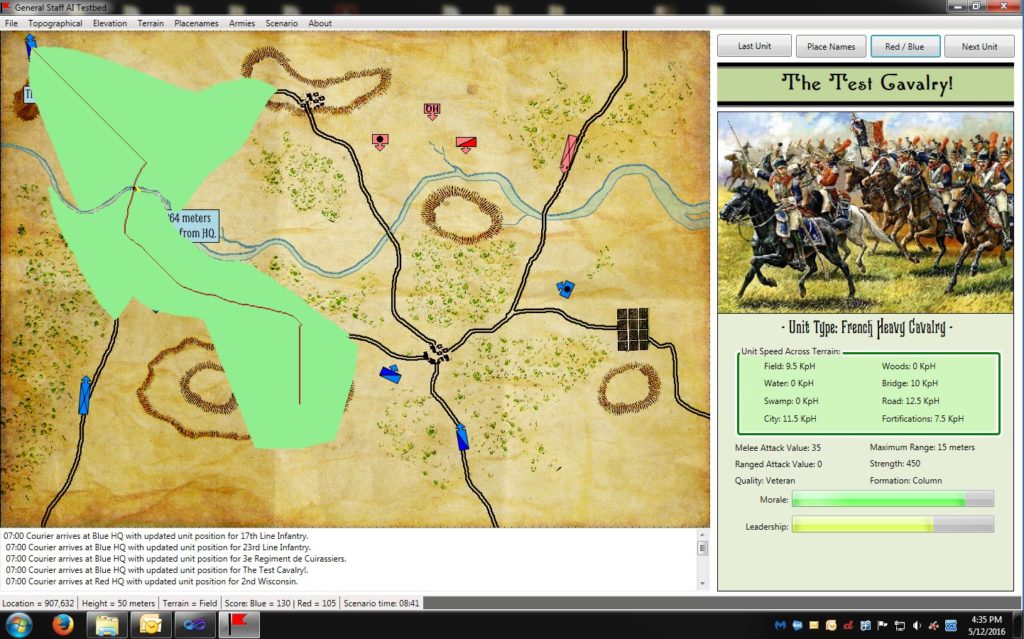
A screen shot showing traditional A* (pronounced A Star) pathfinding. The green areas are ‘nodes’ that the algorithm explored on its way to finding the optimal path (in Brown). Click on picture to enlarge to full size.
Artificial Intelligence (AI) plays an important role in wargame development; it’s what separates a good game from a great game. One of the most important algorithms employed in wargame AI is the A* (pronounced ‘A star’) pathfinding algorithm that was created in 1968 by Peter Hart, Nils Nilsson and Bertram Raphael. The paper describing it, A Formal Basis for Heuristic Determination of Minimum Cost Paths can be downloaded here. I did my doctoral Qualifying Exam on optimized pathfinding. My paper, “An Analysis of Dimdal’s (ex-Jonsson’s) ‘An Optimal Pathfinder for Vehicles in Real-World Terrain Maps'” can be downloaded here.
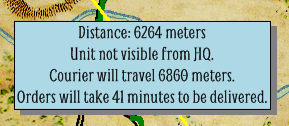
How long will it take for your orders to arrive at this unit? How long will it take for the unit to send a courier back to headquarters with its current location?
Pathfinding is important in wargames because it’s how units, under computer control, move around on the map. Also, and we’re announcing this for the first time here, when you give orders in General Staff a courier has to ride from your headquarters unit to the unit that is to receive your orders. Also, units on the battlefield that are not directly visible to the Headquarters unit (this is done with a 3D Bressenham line algorithm; more about this later) slowly begin to fade from view on the map. However, every hour a courier is dispatched from every unit to headquarters with an update on their position. As we can see from the information box, above, the courier will take 41 minutes to deliver the new position information to headquarters.
The top screen capture shows an implementation of the classic A* algorithm for calculating the optimal path from Blue’s headquarters unit to a far-flung cavalry unit. Note, this is an especially difficult path to calculate because the unit is across a river and there are only three bridges across. The A* algorithm performs perfectly but it is just too slow to be used with a real-time tactical wargame like General Staff. After some thought I wrote a major optimization of A* which we present here for the first time.
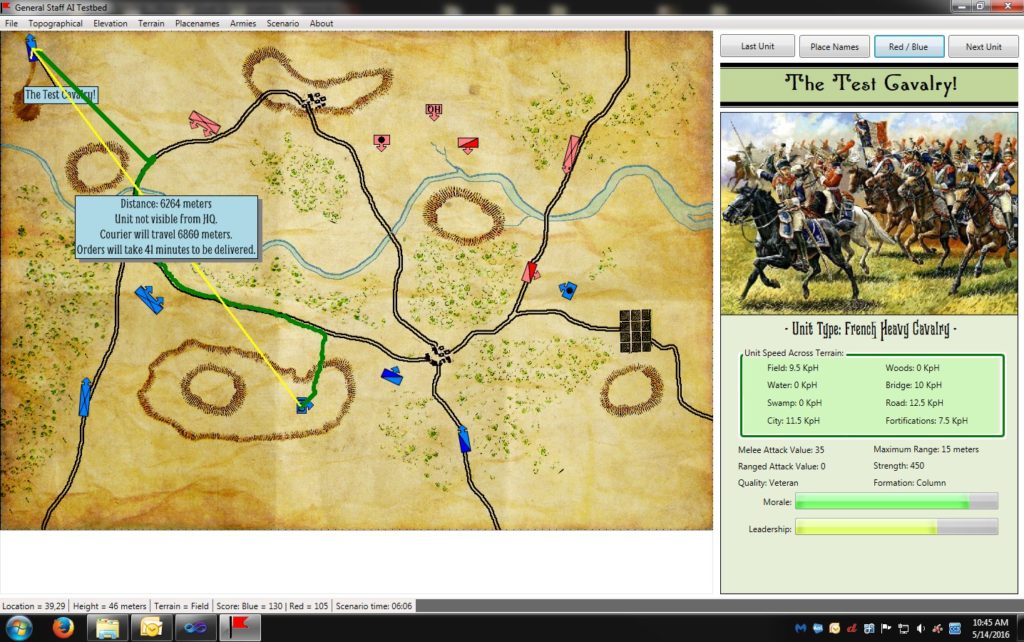
An example of the new EZRoadStar pathfinding algorithm created for General Staff. Compare it to the top screen capture which uses the classic A* algorithm. Click to enlarge.
Above is a screen shot of the results of the new EZRoadStar algorithm. It is almost identical to the original A* algorithm but runs thousands of times faster (my fellow computer scientists would probably prefer if I did some tests, wrote a paper and published the exact figures and I promise I’ll get around to that, some day).
In the screen shot, above, you can see the path of the courier (in green) from the Blue HQ unit to wayward cavalry unit. The new pathfinding algorithm, EZRoadStar, first looks for roads and then calculates how to get on and off the roads. This is much faster than the A* algorithm.

